Inside Intel's Next Unit of Computing (DC3217BY)
by Anand Lal Shimpi on November 9, 2012 1:28 PM EST- Posted in
- Systems
- CPUs
- Intel
- Next Unit of Computing
Back at IDF Intel gave us a hands on demo of its Next Unit of Computing (NUC), a custom form factor motherboard that fits into an Intel-supplied 4" x 4" x 2" chassis. The first-generation NUC is built around a dual-core ULV Ivy Bridge CPU, the Core i3 3217U (17W TDP, 1.8GHz frequency, no turbo, HD 4000 graphics running at 350MHz - 1.05GHz).
Intel will be selling two versions of the NUC: the DC3217IYE and the DC3217BY:
| Intel NUC Kit Comparison | ||||
| DC3217IYE | DC3217BY | |||
| CPU | Intel Core i3-3217U | Intel Core i3-3217U | ||
| Chipset | Intel QS77 Express | Intel QS77 Express | ||
| RAM | 2 x DDR3 SO-DIMM slots | 2 x DDR3 SO-DIMM slots | ||
| HDMI Output | 2 | 1 | ||
| USB | 3 x USB 2.0 | 3 x USB 2.0 | ||
| Gigabit Ethernet | Y | N | ||
| Thunderbolt | N | Y | ||
| mini PCIe (half-height) | 1 | 1 | ||
| mini PCIe (full-height, mSATA support) | 1 | 1 | ||
| Chassis Color | Black | Black with Dark Red Top | ||
| Power Supply | External 19V DC | External 19V DC | ||
Intel sent along the DC3217BY which it expects to see on sale via Amazon and Newegg around early December for $300 - $320. For that price you basically get the motherboard (including CPU) and chassis. Memory, mini PCIe cards and even the power cord all come separately. The power cord you'll need to buy is a C6 type that plugs into the power adapter's C5 type connector. The 3-plug C6 connector is also known as a cloverleaf connector. My assumption here is to keep costs down Intel avoided including this part as they'd need to have a different cable depending on what part of the world the NUC was being sold into. The kit also comes with a VESA mounting bracket.
The main difference between the two models is the presence of GigE (-IYE suffix) vs Thunderbolt (-BY suffix), although the version without Thunderbolt comes with two HDMI ports instead of one. The Thunderbolt version ships with a dark red glossy top (pictured in the gallery below). You can drive a 2560 x 1440 panel off of the Thunderbolt port, although the usual Windows Thunderbolt compatibility requirements apply here.
Building the NUC is incredibly simple. There are four screws that hold the chassis together, removing them gives you access to the motherboard:
You don't actually need to go any further if you just want to get the NUC up and running. From here you can install up to two 8GB DDR3 SO-DIMMs. The bottom mini-PCIe slot accepts a half height card (perfect for WiFi) while the top slot can take a full height card or an mSATA drive. The antenna pigtails for WiFi are already routed to the appropriate spot inside the chassis. This model has an integrated Thunderbolt controller which you can see in the upper right of the machine.
Intel sent along its mSATA SSD 520 (180GB), which is a SandForce based mSATA drive from Intel using 25nm MLC NAND. SandForce controllers work very well in mSATA form factors since they don't require any external DRAM. There are only four IC packages on the mSATA 520: the controller itself plus 3 x 64GB 25nm MLC NAND devices. Intel's SSD Toolbox labels the drive as an SSD 525, however the part numbers above indicate 25nm NAND which would make this a 520.
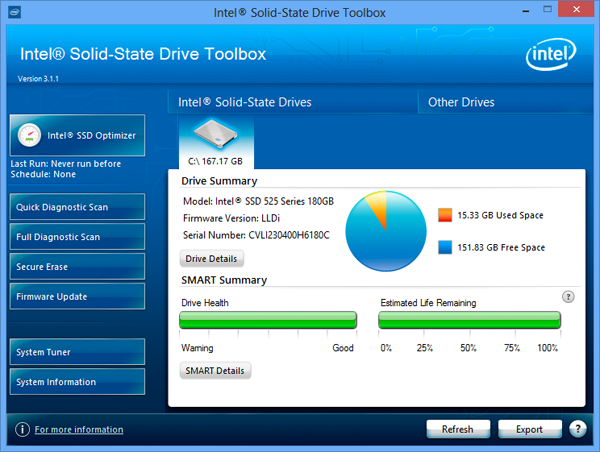
Going further, there are four screws that hold the motherboard in place, remove them and you can pull the board out completely:
On the underside of the motherboard you'll find the heatsink/fan covering the QS77 chipset and the Core i3 CPU:
Under heavy load the fan will kick in, but it's barely audible from more than 18" away from the chassis. The top of the plastic chassis does get quite warm (48.7C) while the CPU is running full tilt. The 65W power adapter will pull around 10W for the full system at idle and peak power consumption for the NUC tops out at 19.3W when running our x264 HD test.
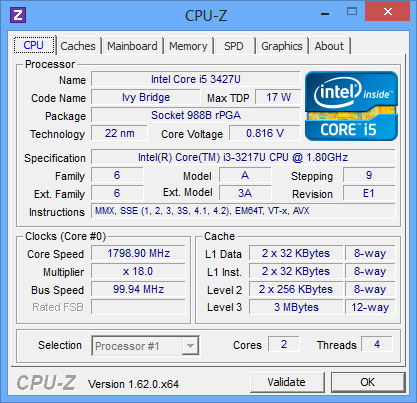
Performance is obviously going to be in line with other 17W mobile Ivy Bridge CPUs. We don't have a huge library of x264 HD 5.0.1 tests to compare to, but this should give you a bit of an idea of how the NUC would compare to a full blown 65W Core i3 based desktop PC:

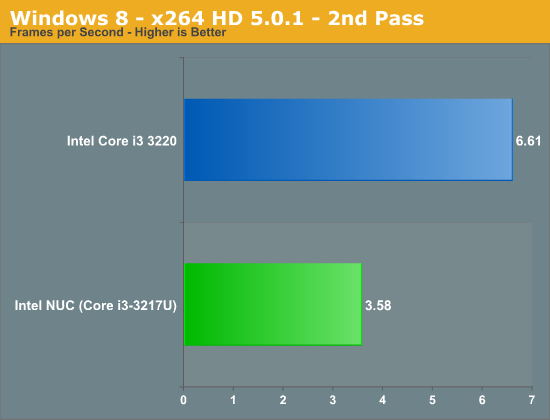
Compute bound tasks will obviously be slower, but lighter usage models will be just fine. Remember that this isn't an Atom based system, you'll actually get decent performance out of it. I'll be running some more benchmarks on the machine over the coming weeks, including a look at GPU performance.
The NUC is a nifty little concept and I'm glad Intel is bringing it to market. Obviously I don't see the NUC replacing everyone's desktop, but if you've got a specific application where form factor matters more than absolute performance (albeit one where you still need good performance) there may be a good fit here. What I'd love to see is for the NUC to be turned into a standard form factor, with a real ecosystem of multiple parts suppliers building components. Intel keeping it all in house, at least for the first revision, makes sense in order to establish a good baseline.









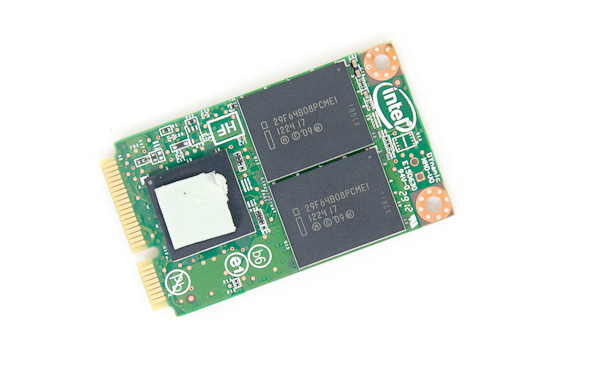
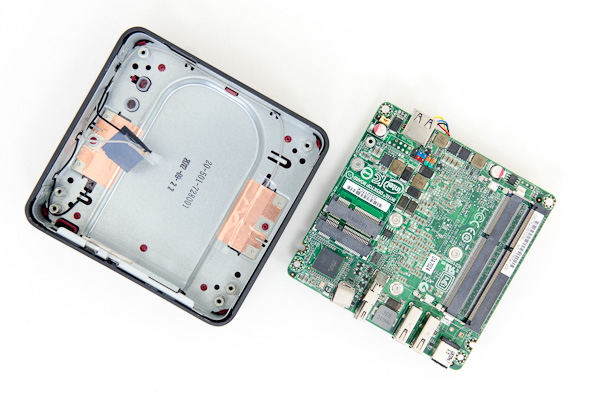
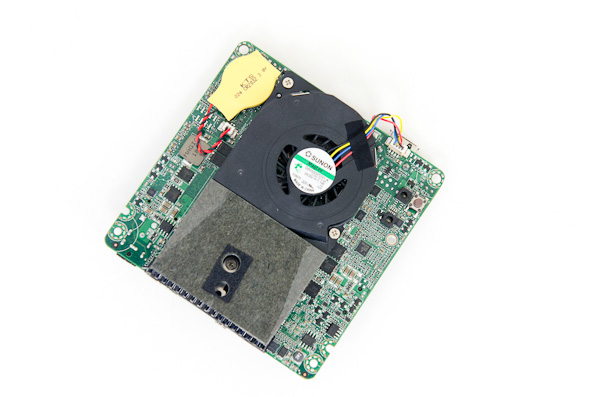








92 Comments
View All Comments
sna2 - Monday, November 12, 2012 - link
the Asrock is the winner here with Moblie 7850 ATI card !!http://www.newegg.com/Product/Product.aspx?Item=N8...
plus you can take a look at this one
http://www.attro.com/embedded/NANO-QM770.htm
and make your own small notebook grade box :D
sna2 - Monday, November 12, 2012 - link
Intel is not the first here.Actually , Mobile motherboards exist for i3/i5/i7 in even smaller factor already.. like Qseven and Pico itx , ...
and are more powerfull than this one , accepts ANY ivy bridge Mobile cpu upto i7 quad core Mobile running at 2.9Ghz and 17-45 watts max TDP depending on the chip you choose.
those motherboards are from 10cmX7cm to 10x10 to 16x12
and they have all the options needed.
the only reason people dont know about them , is that they are industrial motherboards. but since Intel is selling this thing for 400$ Barebone , then it is in the same Category...
here is an example
http://www.attro.com/embedded/NANO-QM770.htm
this motherboard is smaler than mini Itx , takes any Mobile CPU you choose and full of options. the size is 16x12 ..
OR
you can get a standard comn Express Module , and a Com express Carrier Board.
com express carrier Boards example :
http://www.ekf.de/x/xv1/xv1_e.html
and ANY Comexpress Board like this
http://www.msc-ge.com/en/produkte/com/moduls/com_e...
or this
http://www.radisys.com/products/com-express/ceqm77...
OR the Smaller Qseven Boards and their carriers.
(still waiting for Qseven ivy boards)
the Qseven carrier
http://www.seco.com/en/item/secocq7-pitx/
another one
http://www.seco.com/en/item/secocq7-mobile/
( still looking for Qseven ivy bridge mdoules)
but if you want a Ready Mobo without carriers and etc this one
http://www.attro.com/embedded/NANO-QM770.htm
as for cases , look for Pico Itx Cases they are around looong ago.
Intel fails here :)
sna2 - Monday, November 12, 2012 - link
.Onerusone - Tuesday, November 13, 2012 - link
I don't need it to be polished aluminum but glossy red plastic? Apparently all the effort in design went into the guts of it if this is the shipping version. Guess I could live with stuffed behind my monitor and spray painted it black...Ha!draggos - Thursday, November 15, 2012 - link
Lenovo IdeaCentre Q190 goes for $350 with the i3 processor.We'll have to see the exact hw setup of Q190 but I have a feeling that the NUC will be more expensive on comparable hw
DesktopMan - Thursday, November 15, 2012 - link
Some tests of the video decoder would be nice. Also since it doesn't support 10bit h264, a software playback test of that would make sense.dealcorn - Sunday, November 25, 2012 - link
Perspective matters. Where I live electricity is expensive (like Denmark) and the combination of efficiency and HD 4000 graphics that are well supported in Linux make this rather appealing as a pure media consumption device with light Internet browsing. All media is streamed from a server to which I am hardwired and the server has spare capacity on its SSD. I think I will set up a DC3217IYE as a disk-less box with a remote boot drive on SSD. For media consumption and browsing, the CPU and graphics should be more than OK while maintaining reasonable power consumption. The whole deal can be put together with 2 GB of 1.35 memory for well under $350 in that this box is currently listed on Amazon at $308. Separately, I posted a question in the forums to see if I can draw any insight on how disk-less to SSD may affect boot times. I should let that simmer for a day or so before I pull the plug. It is a shame there is no IR port.chrissybabe - Friday, December 14, 2012 - link
If it came with a network port AND a Thunderbolt port AND at least a couple of USB 3 to give some choices I would buy at least 2 of these tomorrow. Couldn't care less about wireless since I have too many wireless devices already. So as it is no thanks.Somewhat like the ipad - could have been a superlative device but instead (deliberately ?) crippled.
provo44 - Sunday, December 16, 2012 - link
Intel NUC Concept Designhttp://www.benjaminsohn.de/project/intel-nuc-conce...
provo44 - Monday, December 17, 2012 - link
A third model (DCCP487DYE) will hit the market during the first quarter of 2013.http://technology-corner.com/intel-next-unit-of-co...